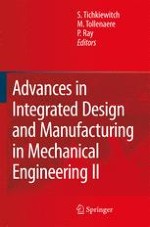2007 | OriginalPaper | Buchkapitel
Modal Tolerancing — Application to Gap and Flush Analyses
verfasst von : Pierre-Antoine Adragna, Serge Samper, Fabien Formosa, Maurice Pillet
Erschienen in: Advances in Integrated Design and Manufacturing in Mechanical Engineering II
Verlag: Springer Netherlands
Aktivieren Sie unsere intelligente Suche, um passende Fachinhalte oder Patente zu finden.
Wählen Sie Textabschnitte aus um mit Künstlicher Intelligenz passenden Patente zu finden. powered by
Markieren Sie Textabschnitte, um KI-gestützt weitere passende Inhalte zu finden. powered by
Tolerancing of geometrical forms is applied either to surfaces or to outlines of parts. We are interested, in this paper to form errors of outlines, but the presented method allows to describe all possible deviations of features as presented in [9]. That is to say that dimension, position, form, and roughness can be analysed by the modal tolerancing.
The measured feature gives a set of points that have to be filtered in order to distinguish those deviations. The decomposition of the measured geometry in a set of modal natural shapes sorts deviations from the lowest to the highest level of complexity. The set of natural modes is a theoretically unlimited basis but by using a discretisation of the feature this set will limited. This method inherits of the modal shape and finite element analysis properties:
Versatility
: any kind of geometry can be analysed.
Deviation unification
: size, position, form and roughness can be analysed.
Form growing complexity
: from large to short wavelengths.
In the case of surfaces, a shell element should be used in the FEA model and in the outline case, a beam(or a bar) model would be better. The behaviour of the element and boundary conditions have to be associated to the kind of deviations specified or observed. The manufacturer can see a decomposition of the actual parts in the modal shapes and look the size of the maximum error in order to control it. The metrologist who uses Fourier decomposition can easily understand this method. As this method gives a language to form errors, every actor of the product can express his needs in an unambiguous way.
In this paper we present an application of the method to an industrial example of a gap and flush analyse of a plastic assembly.
